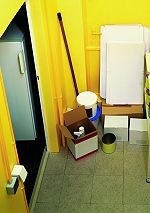Thomas Demand
dal 3/4/2008 al 5/7/2008
Segnalato da
3/4/2008
Thomas Demand
Hamburger Kunsthalle, Hamburg
Camera. The exhibition provides penetrating insight into the underlying political dimension of Demand's art. In his enigmatic images, viewers are confronted with the lies of politics and the depths of normality as well as with modes of surveillance and extortion. What makes his photographs so captivating is the suggestive and uncanny presence of their fictional pictorial settings. Real spaces or scenes that have already been disseminated as images in the print media or via television are painstakingly reconstructed by the artist as life-size models in his studio, which he then records as large-format photographs.

curated by Petra Roettig
Thomas Demand is one of the most internationally renowned artists of his generation. His work was only recently featured in a major exhibition at the Fondazione Prada in Venice, and in 2005 the Museum of Modern Art in New York opened its new building with a monographic exhibition of Demand’s photographs.
The exhibition at the Hamburger Kunsthalle provides penetrating insight into the underlying political dimension of Thomas Demand’s art. In his crystal-clear yet curiously enigmatic images, viewers are confronted with the lies of politics and the depths of normality as well as with modes of surveillance and extortion. What makes Demand’s photographs so captivating is the suggestive and uncanny presence of their fictional pictorial settings. Real spaces or scenes that have already been disseminated as images in the print media or via television are painstakingly reconstructed by the artist as life-size models in his studio, which he then records as large-format photographs.
The Hamburger Kunsthalle presents works by Thomas Demand from the period 2005–2007 in an installation developed by the artist especially for the Galerie der Gegenwart. Beginning with the film-loop piece Camera (2007), the exhibition continues with nine photographs from the series Embassy (2007). These pictures show the Embassy of Niger in Rome, the site of a burglary in which stationary paper was stolen that subsequenty has been used for forged contracts, which served US intelligence services as evidence to support the Iraq War. The series of images is based on research the artist has been doing by himself, as no reporter ever has ever had any access to the site. A second focal point of the exhibition is the work Klause from 2006. It comprises five photographs that were created by Demand in response to Max Beckmann’s lithographic cycle Apocalypse (1941/42). Unlike Beckmann, whose work illustrates the Bible text directly, Demand focuses on a corresponding incident from the recent past, a crime that allegedly took place in the south German town of Burbach (Saarland). This crime was never solved, however, nor was the alleged victim ever found. In these photographs it is not the crime itself that concerns Demand, but the subsequent media coverage of the event.
Biography: born in 1964 in Munich, Thomas Demand studied at the Akademie der Bildenden Künste in Munich from 1987–89, at the Kunstakademie Düsseldorf from 1989–92 and completed his MA at Goldsmiths’ College, London in 1993–94. Demand lives and works in Berlin.
Selected exhibitions: “Processo Grottesco”, Fondazione Prada, Isola San Giorgio Maggiore, Venice, 2007; “L’Esprit de l’Escalier”, Irish Museum of Modern Art, Dublin, 2007; Serpentine Gallery, London, 2006; Thomas Demand & Max Beckmann, Museum für Moderne Kunst, Frankfurt, 2006; Museum of Modern Art, New York, 2005; German Pavilion, XXVI Bienal de São Paulo, São Paulo, 2004; “Phototrophy”, Kunsthaus Bregenz, 2004, Louisiana Museum of Modern Art, Humlebaek, 2003.
Hamburger Kunsthalle
Glockengiesserwall - Hamburg



